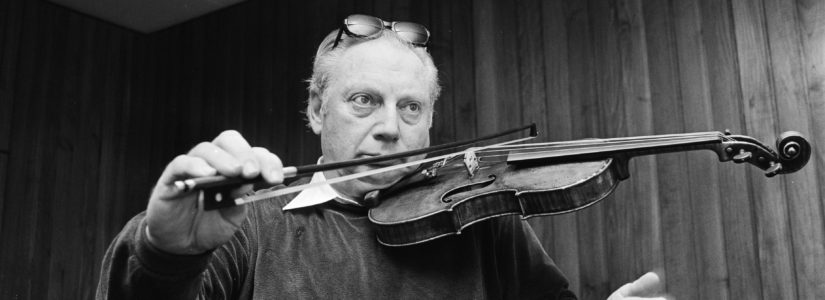
New to the Archive: Isaac Stern Tapes and Edgar Tafel Collection Archived and Available to Public
May 14, 2012
Article from the Spring 2012 Newsletter
In 1943, violinist Isaac Stern (1920-2001) made his Carnegie Hall debut. The great acoustics of the 1891 space did justice to the magnificent talent that would soon make Stern internationally celebrated. Yet just sixteen years later, Stern feared he would never perform at Carnegie Hall again; despite the building’s history and reputation, it faced near-certain demolition. Mayor Robert Wagner and master builder Robert Moses planned to develop a new arts complex at Lincoln Center that they felt would render Carnegie Hall unnecessary. Developers even planned at one point to replace the famed hall with a bright red office tower.
Isaac Stern, inspired by his series of Carnegie Hall performances in December 1959, made it a personal mission to save the building. He convinced philanthropist Jacob Kaplan to fund the preservation effort, and Kaplan eventually pledged $100,000 to the cause. Kaplan’s only stipulation was that Stern himself lead the campaign to convince the City of New York to purchase Carnegie Hall. Indeed, Stern vigorously rallied support among musicians, philanthropists, civic leaders, and the public, gathering thousands of signatures on a petition in support of preserving the hall. Through the Citizens’ Committee to Save Carnegie Hall, Stern ultimately convinced Mayor Wagner that Carnegie Hall could serve as a national center for educating young artists. The New York City Board of Estimate approved the purchase of the building for $5 million in June 1960. Stern was elected the first president of the Carnegie Hall Corporation—a position which he held until his death in 2001—and played a central role in the building’s 1986 restoration and the celebration of its centennial in 1991. The main concert hall was named the Isaac Stern Auditorium in 1997, honoring Stern for what The New York Times called “his long love affair with that hall.”
Thanks to The J. M. Kaplan Fund, the audio recording of a 1986 interview between Roberta Brandes Gratz and Isaac Stern about the Carnegie Hall preservation campaign is now available upon request to the public for personal, research, or educational purposes. Among other interesting insights, Stern recalls in this interview the first meeting of the Committee, discusses tensions with Lincoln Center developers, and expresses his view of the significance of Carnegie Hall.
Soon, students and researchers will have access to the extensive archive of a local architect with significant historical connections and quite a history of his own. Edgar Tafel (1912-2011) served a nine-year apprenticeship with Frank Lloyd Wright and was the last surviving member of the original Taliesin Fellowship. Working with Wright in his studio, Tafel assisted with such iconic projects as Fallingwater and the Johnson Wax Building. Later, despite a sometimes-tense relationship with his mentor, Tafel became a historian of Wright’s work, publishing two books on the architect, assisting with restoration projects on Wright buildings, and helping salvage two Wright interiors from the Francis W. Little House before its demolition in 1971. Tafel also led a successful architectural firm in New York, designing 80 houses, 35 religious buildings and three college campuses over the course of his career, and helped shape Greenwich Village, where he lived and worked for over 40 years. In the Village, he is perhaps best known for his visionary design for the First Presbyterian Church’s Mellin Macnab Building on West 12th Street and Fifth Avenue. He was also a member of the committee to redesign Washington Square Park in 1970, the result of which was much loved by neighborhood residents (the park was recently redesigned and many features of the 1970 plan were changed). Edgar Tafel died in his East 11th Street home at the age of 98.
In January 2012, a year to the day after Tafel’s death, The Edgar A. Tafel Living Trust announced that it would donate his archives and research files—as well as $100,000 to help fund their processing, preservation, and presentation—to the Avery Architectural and Fine Arts Library at Columbia University. Collected from his home and architectural office, the archive includes information on Frank Lloyd Wright, Tafel’s personal drawings, manuscripts, and correspondence, as well as photographs of his designs. After a year of processing, the materials will be available for faculty and student use in 2013. The Columbia Daily Spectator quoted Avery’s Director Carole Ann Fabian as saying, “Tafel had a desire that his assets be given to support architectural education and scholarship.” Thanks to the power of archives, the architect’s desire will be fulfilled.




